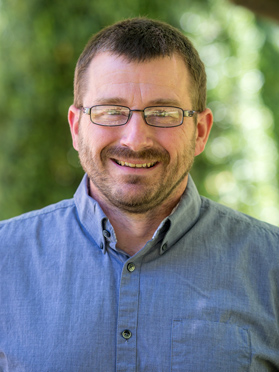-
About
▼
-
Admissions
▼
-
Academics
▼
-
Alumni & Parents
▼
-
Student Life
▼
-
Athletics

POSITION: Professor of Biology; Program Director - Biology, Chemistry, & Environmental Science
DEPARTMENTS:
School of Sciences, Engineering, Art and Nursing
Biology, Chemistry, & Environmental Science
LOCATION: Main Campus, Harrisonburg | SSC 026D
PHONE: (540) 432-4410
EMAIL: yoderjm@emu.edu
Jim is the current program director for the Biology, Biochemistry, Chemistry, Medical Laboratory Sciences and Environmental Science programs. He advises Environmental Science and biology majors and primarily teaches in the areas of evolution, ecology and conservation biology. He earned his Ph.D. from the Ohio State University and his primary research interests include conservation biology, landscape ecology, behavioral ecology and animal movement. Early research focused on population and behavioral responses of species to habitat fragmentation. His dissertation research at The Ohio State University was in collaboration with the Ohio Division of Wildlife and examined the effects of fragmented habitat on the dispersal and population dynamics of ruffed grouse in southeastern Ohio.
In 2006 he began a long-term collaborative study working with Shenandoah National Park research botanist, Wendy Cass. The research was conducted by 2-3 EMU undergraduates per year (including summers) as well as SNP personnel. The project includes intense on-site field sampling as well as mapping and analysis of exotic plant spread and impact using GIS. The project addressed two specific research questions that focused on the exotic plants invading the Shenandoah National Park: 1) What is the rate of spread of the three most threatening exotic species beginning to invade the Big Meadows Swamp Natural Heritage area and 2) What is the impact of these exotics on the continued viability of the eight rare plant species located within the area?
In the fall of 2014, Jim began a stream restoration and monitoring project in the German River and Crab Run watersheds near Bergton, VA. This was a collaborative project with initial funding provided by a grant from the National Fish and Wildlife Foundation grant that included partnering with EMU colleague Dr. Doug Graber Neufeld, Ecosystem Services, LLC., Tom Akre at the Smithsonian Conservation Biology Institute and EMU’s Center for Justice and Peace. The immediate goals of the project were to conduct a watershed assessment and restore two sections of stream as well as assess potential strategies to encourage adoption of best management practices by community members. His students specifically worked on stream macroinvertebrate monitoring of restoration impacts and long-term population trends of Wood turtles in the watersheds.
In 2018 he has become involved in nitrogen footprint tracking, becoming a member of the Nitrogen Footprint Working Group centered at the University of New Hampshire Center for Sustainability and the University of Virginia. Current projects involve tracking carbon and nitrogen footprints at both EMU and for the City of Harrisonburg and working on footprint reduction scenarios and goal setting.
Most recently, in the fall of 2021, he joined colleague Dr. Matt Siderhurst to collaborate on the study of movement of Tephritid fruit flies and other insects using harmonic radar technology. In the summers of 2022, 2023 & 2024 he accompanied 20 undergraduate students to Australia as part of Dr. Siderhurst’s NSF IRES grant to continue the work harmonic radar work on Queensland fruit flies with researchers at Macquarie University in Sydney, James Cook University in Townsville, NSW and researchers at the Department of Agricultural and Fisheries in Mareeba, NSW. Jim and Matt are continuing to collaborate on various projects tracking insect movements using harmonic radar to better model outbreaks and dispersal of agricultural pests.
Jim is also heavily involved in study abroad education and has led inter-cultural trips to New Zealand in the summer of 2010 (6 weeks), fall 2012 (full semester) and summer of 2015 (6 weeks) with his wife Kathy Yoder. The trips focused on sustainability issues related to tourism, natural resource conservation, and agriculture as well as indigenous Maori culture, restorative justice and New Zealand history. He also co-led two 3-week summer cross-cultural trip to Navajo Nation in Arizona focusing on similar themes with the Navajo and Apache peoples, first with Dr. Gloria Rhodes (2017) and most recently with Kathy Yoder (2021). In March of 2023 he led a 3-week alumni cross-cultural trip to New Zealand and in summer of 2024 he will co-lead a 3 week inter-cultural trip to Washington DC focusing on Urban Sustainability and Environmental Justice with WCSC faculty Ann Butwell. In addition to inter-cultural trips, Jim has co-led three research trips to Sydney and North Queensland, Australia with 20 students from EMU, Bridgewater, and JMU over three years.
In addition to teaching, Jim is the curator of the D. Ralph Hostetter Museum of Natural History and the faculty resource person and chair of the implementation team for the Peace with Creation Quality Enhancement Plan (QEP), a 5-year initiative drawing together EMU students, faculty and staff around the theme of sustainability and how it relates to Anabaptist beliefs concerning creation care, peace and social justice.
PHD, Ohio State University (Evolution, Ecology & Organismal Biology)
BS, Eastern Mennonite University (Biology with a Minor in Computer Science & English)